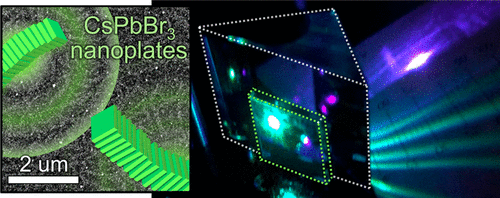当前位置:
X-MOL 学术
›
ACS Photonics
›
论文详情
Our official English website, www.x-mol.net, welcomes your
feedback! (Note: you will need to create a separate account there.)
Planar Optical Waveguides Using Poly(styrene-ethylene-butylene-styrene) Activated with Inorganic Lead Halide Perovskite Nanoplates
ACS Photonics ( IF 6.5 ) Pub Date : 2020-08-07 , DOI: 10.1021/acsphotonics.0c00478 Tsafrir Abir 1, 2 , Reut Shechter 3 , Tal Ellenbogen 2 , Yehonadav Bekenstein 3
ACS Photonics ( IF 6.5 ) Pub Date : 2020-08-07 , DOI: 10.1021/acsphotonics.0c00478 Tsafrir Abir 1, 2 , Reut Shechter 3 , Tal Ellenbogen 2 , Yehonadav Bekenstein 3
Affiliation

|
Lead halide perovskite nanoplates support strongly quantum confined excitons, high photoluminescence quantum yield, fast and narrow photoluminescence spectra. Future use of these nanomaterials is strongly dependent on the ability to enhance their stability and engineer the out-coupling of excitonic emission. Optical waveguides can harness their attractive optical properties enabling integration into photonic devices and preventing degradation. In this study we activate planar polymer waveguides of poly(styrene-ethylene-butylene-styrene) with colloidally synthesized CsPbBr3 nanoplates and study interactions between perovskite confined excitons and the optical waveguide modes. Beyond optical engineering, the polymer forming the waveguide serves also to encapsulate the perovskite nanocrystals, protecting them from the environment. Angle-dependent photoluminescence measurements indicate coupling between the quantum confined excitons in the nanoplates and the planar guided modes. This is evident by the emission of photons with momenta and polarization states matching those of the guided modes. We achieve an order of magnitude shortening of the emission lifetime via Purcell effect. Achieving fast emission from perovskite nanoplate activated waveguides is of interest in the context of searching for an efficient and coherent single photon source. These findings can serve as a first engineering step in the direction for a more complex nanoperovskite waveguide based photonic structure.
中文翻译:

无机卤化卤化钙钛矿纳米板活化的聚(苯乙烯-乙烯-丁烯-苯乙烯)平面光波导
卤化钙钛矿铅纳米板支持强量子约束激子,高光致发光量子产率,快速和窄光致发光光谱。这些纳米材料的未来用途在很大程度上取决于增强其稳定性和设计激子发射的输出耦合的能力。光波导可以利用其吸引人的光学特性,从而可以集成到光子器件中并防止退化。在这项研究中,我们用胶体合成的CsPbBr 3激活了聚(苯乙烯-乙烯-丁烯-苯乙烯)的平面聚合物波导纳米板并研究钙钛矿约束激子与光波导模式之间的相互作用。除光学工程外,形成波导的聚合物还用于封装钙钛矿纳米晶体,保护其免受环境污染。角度相关的光致发光测量结果表明,纳米板中的量子约束激子与平面导模之间存在耦合。通过具有与引导模式相匹配的动量和偏振态的光子发射,可以证明这一点。通过珀塞尔效应,我们可以缩短发射寿命一个数量级。在寻找有效且相干的单光子源的背景下,实现钙钛矿纳米板活化波导的快速发射十分重要。
更新日期:2020-09-16
中文翻译:

无机卤化卤化钙钛矿纳米板活化的聚(苯乙烯-乙烯-丁烯-苯乙烯)平面光波导
卤化钙钛矿铅纳米板支持强量子约束激子,高光致发光量子产率,快速和窄光致发光光谱。这些纳米材料的未来用途在很大程度上取决于增强其稳定性和设计激子发射的输出耦合的能力。光波导可以利用其吸引人的光学特性,从而可以集成到光子器件中并防止退化。在这项研究中,我们用胶体合成的CsPbBr 3激活了聚(苯乙烯-乙烯-丁烯-苯乙烯)的平面聚合物波导纳米板并研究钙钛矿约束激子与光波导模式之间的相互作用。除光学工程外,形成波导的聚合物还用于封装钙钛矿纳米晶体,保护其免受环境污染。角度相关的光致发光测量结果表明,纳米板中的量子约束激子与平面导模之间存在耦合。通过具有与引导模式相匹配的动量和偏振态的光子发射,可以证明这一点。通过珀塞尔效应,我们可以缩短发射寿命一个数量级。在寻找有效且相干的单光子源的背景下,实现钙钛矿纳米板活化波导的快速发射十分重要。











































 京公网安备 11010802027423号
京公网安备 11010802027423号